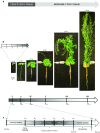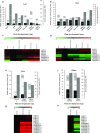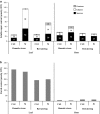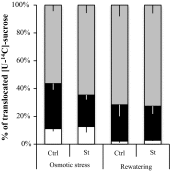Carbon source-sink relationship in Arabidopsis thaliana: the role of sucrose transporters
- PMID: 29138971
- PMCID: PMC5809531
- DOI: 10.1007/s00425-017-2807-4
Carbon source-sink relationship in Arabidopsis thaliana: the role of sucrose transporters
Abstract
The regulation of source-to-sink sucrose transport is associated with AtSUC and AtSWEET sucrose transporters' gene expression changes in plants grown hydroponically under different physiological conditions. Source-to-sink transport of sucrose is one of the major determinants of plant growth. Whole-plant carbohydrates' partitioning requires the specific activity of membrane sugar transporters. In Arabidopsis thaliana plants, two families of transporters are involved in sucrose transport: AtSUCs and AtSWEETs. This study is focused on the comparison of sucrose transporter gene expression, soluble sugar and starch levels and long distance sucrose transport, in leaves and sink organs (mainly roots) in different physiological conditions (along the plant life cycle, during a diel cycle, and during an osmotic stress) in plants grown hydroponically. In leaves, the AtSUC2, AtSWEET11, and 12 genes known to be involved in phloem loading were highly expressed when sucrose export was high and reduced during osmotic stress. In roots, AtSUC1 was highly expressed and its expression profile in the different conditions tested suggests that it may play a role in sucrose unloading in roots and in root growth. The SWEET transporter genes AtSWEET12, 13, and 15 were found expressed in all organs at all stages studied, while differential expression was noticed for AtSWEET14 in roots, stems, and siliques and AtSWEET9, 10 expressions were only detected in stems and siliques. A role for these transporters in carbohydrate partitioning in different source-sink status is proposed, with a specific attention on carbon demand in roots. During development, despite trophic competition with others sinks, roots remained a significant sink, but during osmotic stress, the amount of translocated [U-14C]-sucrose decreased for rosettes and roots. Altogether, these results suggest that source-sink relationship may be linked with the regulation of sucrose transporter gene expression.
Keywords: Diel cycle; Full life development; Hydroponic culture; Osmotic stress; Roots; Sugar transporter gene expression.
Figures










Similar articles
-
Water Deficit Enhances C Export to the Roots in Arabidopsis thaliana Plants with Contribution of Sucrose Transporters in Both Shoot and Roots.Plant Physiol. 2016 Mar;170(3):1460-79. doi: 10.1104/pp.15.01926. Epub 2016 Jan 22. Plant Physiol. 2016. PMID: 26802041 Free PMC article.
-
[Functional analysis on sucrose transporters in sweet potato].Sheng Wu Gong Cheng Xue Bao. 2023 Jul 25;39(7):2772-2793. doi: 10.13345/j.cjb.220979. Sheng Wu Gong Cheng Xue Bao. 2023. PMID: 37584131 Chinese.
-
Effective carbon partitioning driven by exotic phloem-specific regulatory elements fused to the Arabidopsis thaliana AtSUC2 sucrose-proton symporter gene.BMC Plant Biol. 2009 Jan 20;9:7. doi: 10.1186/1471-2229-9-7. BMC Plant Biol. 2009. PMID: 19154603 Free PMC article.
-
Sugar transporters in grasses: Function and modulation in source and storage tissues.J Plant Physiol. 2021 Nov;266:153541. doi: 10.1016/j.jplph.2021.153541. Epub 2021 Oct 2. J Plant Physiol. 2021. PMID: 34634553 Review.
-
Understanding and manipulating sucrose phloem loading, unloading, metabolism, and signalling to enhance crop yield and food security.J Exp Bot. 2014 Apr;65(7):1713-35. doi: 10.1093/jxb/ert416. Epub 2013 Dec 17. J Exp Bot. 2014. PMID: 24347463 Review.
Cited by
-
S1 basic leucine zipper transcription factors shape plant architecture by controlling C/N partitioning to apical and lateral organs.Proc Natl Acad Sci U S A. 2024 Feb 13;121(7):e2313343121. doi: 10.1073/pnas.2313343121. Epub 2024 Feb 5. Proc Natl Acad Sci U S A. 2024. PMID: 38315839 Free PMC article.
-
Identification of the SUT Gene Family in Pomegranate (Punica granatum L.) and Functional Analysis of PgL0145810.1.Int J Mol Sci. 2020 Sep 10;21(18):6608. doi: 10.3390/ijms21186608. Int J Mol Sci. 2020. PMID: 32927615 Free PMC article.
-
Cellular export of sugars and amino acids: role in feeding other cells and organisms.Plant Physiol. 2021 Dec 4;187(4):1893-1914. doi: 10.1093/plphys/kiab228. Plant Physiol. 2021. PMID: 34015139 Free PMC article. Review.
-
Cloning and Functional Assessments of Floral-Expressed SWEET Transporter Genes from Jasminum sambac.Int J Mol Sci. 2019 Aug 16;20(16):4001. doi: 10.3390/ijms20164001. Int J Mol Sci. 2019. PMID: 31426432 Free PMC article.
-
Molecular identification and expression analysis of five sucrose synthase genes in Sorghum Bicolor.Physiol Mol Biol Plants. 2022 Apr;28(4):697-707. doi: 10.1007/s12298-022-01166-8. Epub 2022 Apr 22. Physiol Mol Biol Plants. 2022. PMID: 35592480 Free PMC article.
References
-
- Ali ML, Luetchens J, Singh A, Shaver T, Kruger G, Lorenz A. Greenhouse screening of maize genotypes for deep root mass and related root traits and their association with grain yield under water-deficit conditions in the field. Euphytica. 2016;207(1):79–94. doi: 10.1007/s10681-015-1533-x. - DOI
-
- Angeles-Núñez JG, Tiessen A. Mutation of the transcription factor LEAFY COTYLEDON 2 alters the chemical composition of Arabidopsis seeds, decreasing oil and protein content, while maintaining high levels of starch and sucrose in mature seeds. J Plant Physiol. 2011;168(16):1891–1900. doi: 10.1016/j.jplph.2011.05.003. - DOI - PubMed
-
- Arteca RN, Arteca JM. A novel method for growing Arabidopsis thaliana plants hydroponically. Physiol Plant. 2000;108(2):188–193. doi: 10.1034/j.1399-3054.2000.108002188.x. - DOI
MeSH terms
Substances
LinkOut - more resources
Full Text Sources
Other Literature Sources
Molecular Biology Databases

